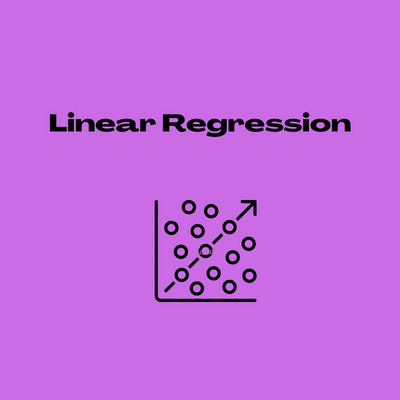#LogisticRegression
Explore tagged Tumblr posts
Text
Unlocking the Power of Logistic Regression and Naive Bayes for SEO and Sentiment Analysis

In the evolving world of SEO optimization and digital marketing, data-driven strategies play a pivotal role. Two advanced techniques, Logistic Regression and Naive Bayes, are transforming the way websites optimize their content and analyze user sentiments, providing deeper insights and better engagement outcomes.
Logistic Regression: Enhancing Predictions in SEO
Logistic Regression is a machine learning technique that predicts binary outcomes (e.g., success vs. failure). In SEO, it can forecast the likelihood of a webpage achieving a certain ranking based on factors like backlinks, page speed, and content quality. This approach allows marketers to focus their resources on elements most likely to improve SERP rankings. Logistic regression models are also used in understanding how variables such as keyword density and user engagement metrics influence a site's overall performance. By applying these insights, businesses can craft precise strategies tailored to their audience and goals.
Naive Bayes: Understanding Sentiments for Better User Experience
The Naive Bayes classifier is instrumental in sentiment analysis. By analyzing customer reviews, social media interactions, and website content, it categorizes sentiments into positive, negative, or neutral. This empowers businesses to understand user perceptions about their brand or product. For example, analyzing the sentiments expressed in reviews can inform content adjustments or service improvements, enhancing customer satisfaction and engagement.
The combination of Naive Bayes with NLP tools enables businesses to process large datasets efficiently, uncovering trends that would be missed with manual reviews. This not only streamlines content strategies but also ensures alignment with user expectations.
Hyper Intelligent SEO: A Game-Changer
When integrated with tools like AI-powered keyword extractors and semantic search optimization, both methods amplify the effectiveness of SEO strategies. Advanced analytics such as TF-IDF keyword extraction or BERT modeling for context optimization ensure that content resonates with search intent, improving rankings and user relevance.
Elevating Strategies with Hyper-Intelligent SEO
Integrating Hyper Intelligence SEO with these machine learning methods amplifies their impact. Advanced tools such as TF-IDF keyword extractors, semantic analysis, and BERT-based contextual modeling ensure content aligns with both user expectations and Google's evolving algorithms. This holistic approach guarantees a competitive edge in the ever-changing digital landscape.
0 notes
Text
Machine Learning Algorithms for Beginners: A Simple Guide to Getting Started
Machine learning (ML) algorithms are powerful tools that allow computers to learn from data, identify patterns, and make decisions without explicit programming. These algorithms are categorized into three types: supervised learning, unsupervised learning, and reinforcement learning.
Supervised Learning involves training a model on labeled data, where each input has a corresponding output. Common algorithms in this category include linear regression (used for predicting continuous values), logistic regression (for binary classification), and decision trees (which split data based on certain criteria for classification or regression tasks).
Unsupervised Learning is used when there are no labels in the data. The algorithm tries to find hidden patterns or groupings. K-means clustering is a popular algorithm that divides data into clusters, while Principal Component Analysis (PCA) helps reduce data complexity by transforming features.
Reinforcement Learning is based on learning through interaction with an environment to maximize cumulative rewards. An example is Q-learning, where an agent learns which actions to take based on rewards and penalties.
Selecting the right algorithm depends on the problem you want to solve. For beginners, understanding these basic algorithms and experimenting with real-world data is key to mastering machine learning. As you practice, you’ll gain the skills to apply these algorithms effectively.
For deeper knowledge on machine learning algorithms, here is a blog where I learned more about these concepts.
#MachineLearning#MLAlgorithms#SupervisedLearning#UnsupervisedLearning#ReinforcementLearning#DataScience#AI#DataAnalysis#LinearRegression#LogisticRegression#DecisionTrees#KMeans#PCA#DataClustering#Qlearning#ArtificialIntelligence#DeepLearning#TechForBeginners#LearnMachineLearning#DataScienceForBeginners#AIinPractice
1 note
·
View note
Text
Logistic Regression (Multiclass Classification)

Multiclass Classification using Logistic Regression for Handwritten Digit Recognition
In the realm of machine learning, logistic regression isn't just limited to binary classification tasks. In this tutorial, we'll delve into how logistic regression can be employed for multiclass classification. We'll use the `LogisticRegression` class from the `sklearn` library to predict handwritten digits. To make this journey informative and engaging, we'll illustrate every step with code examples and visualizations.
Loading the Dataset
Before we start building our classifier, let's get acquainted with the dataset we'll be working with. We'll use the `load_digits` function from `sklearn.datasets` to load a collection of 8x8 pixel images of handwritten digits.
from sklearn.datasets import load_digits
import matplotlib.pyplot as plt
digits = load_digits()
# Display the first five images
plt.gray()
for i in range(5):
plt.matshow(digits.images[i])
plt.show()
Dataset Details
The loaded dataset contains the following attributes:
- `DESCR`: Description of the dataset
- `data`: Array of feature vectors representing the digits
- `images`: Images of the handwritten digits
- `target`: Target labels corresponding to the digits
- `target_names`: Names of the target classes (digits 0-9)
Training the Classifier
We'll employ logistic regression to train a multiclass classification model. Let's start by splitting our dataset into training and testing sets using the `train_test_split` function.
from sklearn.linear_model import LogisticRegression
from sklearn.model_selection import train_test_split
# Split the data into training and testing sets
X_train, X_test, y_train, y_test = train_test_split(digits.data, digits.target, test_size=0.2)
# Create and train the logistic regression model
model = LogisticRegression()
model.fit(X_train, y_train)
Evaluating Model Accuracy
Once our model is trained, it's crucial to evaluate its performance. We can do this by calculating the accuracy on the testing set.
accuracy = model.score(X_test, y_test)
print("Model Accuracy:", accuracy)
Making Predictions
We're now equipped to make predictions using our trained model. Let's predict the first five digits from our dataset and observe the results.
predictions = model.predict(digits.data[0:5])
print("Predictions for the first five digits:", predictions)
Visualizing the Confusion Matrix
A confusion matrix provides deeper insights into the performance of our classifier. It reveals how well the model is classifying each digit.
from sklearn.metrics import confusion_matrix
import seaborn as sns
# Predict on the test set
y_predicted = model.predict(X_test)
# Create the confusion matrix
cm = confusion_matrix(y_test, y_predicted)
# Visualize the confusion matrix
plt.figure(figsize=(10, 7))
sns.heatmap(cm, annot=True)
plt.xlabel('Predicted')
plt.ylabel('True')
plt.show()
Conclusion
In this tutorial, we explored how to use logistic regression for multiclass classification. We employed the `LogisticRegression` class from `sklearn` to build a model capable of recognizing handwritten digits. We split the data, trained the model, evaluated its accuracy, made predictions, and visualized the confusion matrix to assess the model's performance. Logistic regression, once thought of as solely binary, showcases its versatility and effectiveness in tackling multiclass classification tasks.
Remember, the journey of machine learning is full of exploration and experimentation. By understanding the techniques and methods available, you'll be better equipped to create intelligent systems that can interpret and classify diverse data.
@talentserve
0 notes
Text
Hyperparameter Tuning Logistic Regression: Mastering Model Optimization
Dive into Hyperparameter Tuning for Logistic Regression! Learn to optimize your model's performance with GridSearchCV. Boost your machine learning skills now! #MachineLearning #LogisticRegression #Optimization
Hyperparameter tuning in Logistic Regression is a crucial skill for enhancing model performance. This process involves adjusting external parameters to optimize the model’s accuracy and efficiency. In this blog post, we’ll explore the intricacies of hyperparameter tuning, focusing on the Logistic Regression algorithm and its key hyperparameter, ‘C’. Understanding Hyperparameters in Machine…
0 notes
Text

DEVELOPING A WHITE LABEL MACHINE LEARNING PLATFORM FOR SMALL BUSINESSES AS A SAAS. V 2.0
Proposal: Developing a white label machine learning platform for small businesses as a SaaS.
Definition: "SohoMind" - A white-label machine learning platform as a SaaS, designed to empower small and medium-sized businesses to leverage machine learning capabilities without requiring extensive technical expertise.
The ideas are like fleas, they jump out at you, some come to nothing and if one bites, it becomes reality.
In today's AI landscape, people are looking for opportunities to create AI tools.
The big problem is resources such as: investments, technicians, software, equipment and internal and external storage media.
Start ups and incubators have the capacity to select ideas that follow their own regional and cultural parameters. They are in a hermetic aquarium that doesn't allow them to see outside the box.
They favor the interests of investors and often leave out the real needs of industries.
If we follow the protocols of conduct, we have ideas that don't develop, like fleas that don't bite.
Considering ethics without NDA, I don't care about the rules, which were made to be broken.
I'm presenting a business proposal to the global market, looking for a partnership to develop this idea: " Create a Machine Learning for the Soho market where small and medium-sized businesses will be assisted by a SaaS ML".
I am available to study partnership proposals to develop this idea!
Potential features and functionalities for the platform:
1. Data integration: Connects with databases, APIs, and files for machine learning tasks.
2. Pre-built algorithms: Offers ready-made ML algorithms for classification, regression, clustering, and recommendation systems.
3. Customizable models: Allows businesses to train their own ML models with their data.
4. User-friendly interface: Easy data manipulation, algorithm selection, and model training.
5. Scalability: Handles large data volumes and complex ML tasks.
6. Security: Ensures data encryption and secure storage.
7. Integration: Integrates with platforms like hubspot, Shopify, Salesforce, and Zapier.
8. Affordable pricing: Tailored plans including free and paid tiers.
9. Support and resources: Documentation, tutorials, and customer support.
10. Custom branding: Lets businesses match the platform's branding with their own identity.
Potential Features and Functionality, and snippet codes as POC:
1. Data Integration:
```python
import pandas as pd
from sqlalchemy import create_engine
# Connect to a database
engine = create_engine('postgresql://user:password@host:port/dbname')
df = pd.read_sql_query("SELECT FROM table_name", engine)….
2. Pre-built Algorithms:
```python
from sklearn.linear_model import LogisticRegression
from sklearn.ensemble import RandomForestClassifier
# Load pre-trained model
model = LogisticRegression()
# Train the model on the data
model.fit(X_train, y_train)….
3. Customizable Models:
```python
from sklearn.model_selection import train_test_split
from sklearn.metrics import accuracy_score
# Split data into training and testing sets
X_train, X_test, y_train, y_test = train_test_split(X, y, test_size=0.2, random_state=42)
# Train a custom model
model = CustomModel()
model.fit(X_train, y_train)……
4. User-friendly Interface:
```python
import streamlit as st
# Create a Streamlit app
st.title("SohoMind")
st.write("Welcome to SohoMind!")…….
5. Scalability:
```python
import dask.dataframe as dd
# Load large dataset
df = dd.read_csv('large_data.csv')
# Scale the data for processing
df = df.compute()……
6. Security:
```python
import cryptography.fernet
# Generate a secret key
secret_key = cryptography.fernet.generate_key()…..
7. Integration:
```python
import hubspot
# Connect to HubSpot API
hubspot = hubspot.HubspotAPI()….
10. Custom Branding:
```python
import streamlit as st
# Set custom branding
st.set_page_config(page_title="Custom Brand", page_icon="custom_icon.png")….

0 notes
Text
regression-modeling-practice Course Week_4
Test a Logistic Regression Model
(Testen Sie ein logistisches Regressionsmodell)
My Code

we have to create categories if we have quantative variable;
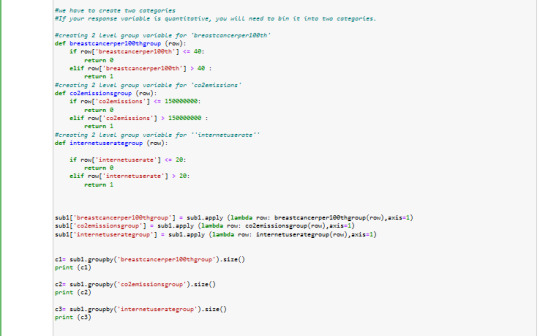
my groups with values
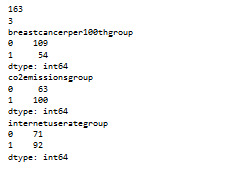
logisticregression with cat.values
Modell1
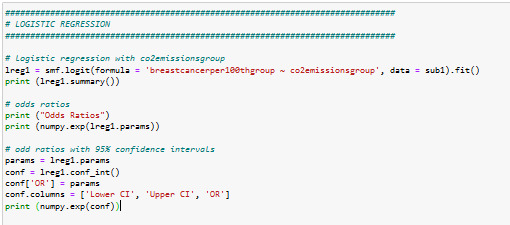
First logistic regression model is with Co2emissionsgroup
responce variable is breascanser100thgroup which was created in first code area.
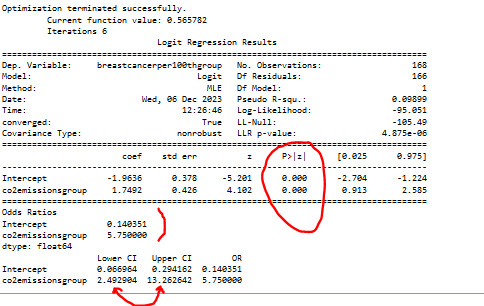
P value is <0.05 for co2emissionsgroup. in This case significant.
The odds ratio indicates that there's a 95% certainty that
the population odds ratio fall between 2.5 and 13.1
Based on our model those with higher CO2 emission
are anywhere from 2,49 to 13.2 times
more likely to have a breascanser than those with lower CO2 emissions.
But I know from old calculations it was a very low R squared Value.
I'll test an other modell
Modell2

second logistic regression model is with Co2emissionsgroup and internetuseragroup
responce variable is breascanser100thgroup which was created in first code area.
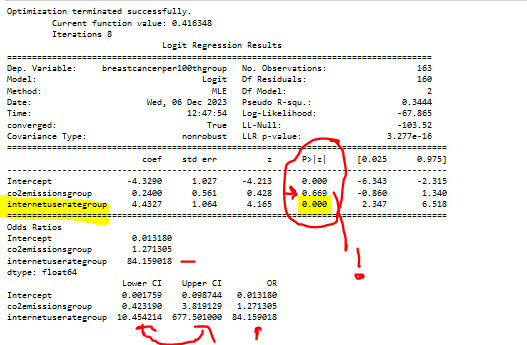
.
We would say that internetuserate confounds the relationship between co2emissions and breastcancer because the P-Value for co2emissions is no longer significant when intenetuserate is included in the model.
Further, because co2emissions is no longer associated with breastcancer , we would not interpret the corresponding odds ratio, but would interpret the significant odds ratio between internetuserate and breastcancer.
That is, women with more internetuserate 84 times more likely to have breastcancer than women with lower internetuserate after controlling for co2emissions. (see my groups for rates. higher internetuse group is >20% internetuserate)
The odds ratio indicates that there's a 95% certainty that the population odds ratio fall between 10,45 and 677,5
Based on our model those with higher internetuserate are anywhere from 10,45to 677,5 times more likely to have a breascanser than those with lower internetuserate.
Modell 3
in this Modell I have only internetuserate as explanatory variable.
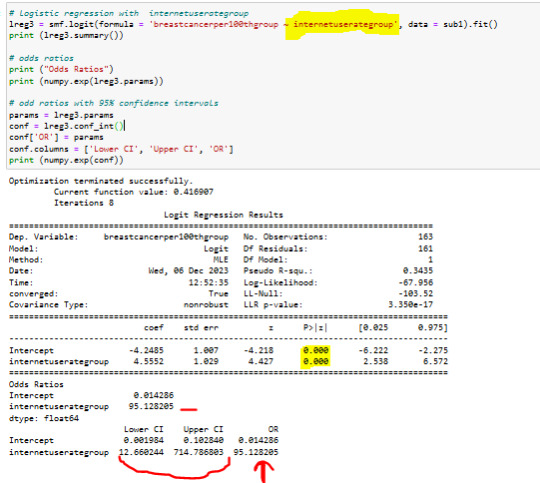
P value is <0.05 for internetuserategroup.
In This case significant.
women with more internetuserate 95 times more likely to have breastcancer than women with lower internetuserate . (see my groups for rates. higher internetuse group is >20% internetuserate)
The odds ratio indicates that there's a 95% certainty that the population odds ratio fall between 12.5 and 714.78
Based on our model those with higher internetuserate are anywhere from 12,5 to 714,8 times more likely to have a breascanser than those with lower internetuserate.
0 notes
Text
Boosting Sales with AI: From Predictive Analytics to Customer Insights

Introduction In the contemporary business landscape, Artificial Intelligence (AI) has become a vital tool for boosting sales. From leveraging predictive analytics to gaining customer insights, AI technologies are transforming how businesses approach sales strategies. This comprehensive article will explore the multifaceted role of AI in sales, encompassing practical examples, code snippets, and actionable insights. Section 1: AI in Predictive Sales Analytics - Forecasting Sales with Machine Learning: - AI algorithms can predict future sales trends by analyzing historical sales data, market trends, and consumer behavior patterns. - Practical Example: Retail chains use AI to forecast demand for products, thereby optimizing stock levels. - Code Snippet: Sales Forecasting Model: from sklearn.ensemble import RandomForestRegressor model = RandomForestRegressor() model.fit(historical_sales_data, sales_targets) predicted_sales = model.predict(future_dates_data) - Insight: Accurate sales forecasts enable businesses to make data-driven decisions, reducing the risk of overstocking or stockouts. Section 2: Enhancing Customer Relationship Management (CRM) with AI - AI-Driven CRM Tools: - Integrating AI into CRM systems provides deeper insights into customer preferences and behaviors, enhancing customer engagement strategies. - Example: AI-powered CRM systems that offer personalized communication strategies based on customer interaction histories. - Code Snippet: Personalized CRM Messaging: from sklearn.cluster import KMeans kmeans = KMeans(n_clusters=5) customer_segments = kmeans.fit_predict(customer_interaction_data) personalized_messages = generate_messages_for_segments(customer_segments) - Application: Personalized CRM approaches can significantly improve customer engagement and loyalty. Section 3: AI in Lead Generation and Qualification - Automating Lead Generation: - AI tools can automate the process of identifying and qualifying potential leads from various data sources. - Practical Example: Using AI to analyze social media and web interactions to generate and qualify leads. - Code Snippet: Lead Qualification: from sklearn.linear_model import LogisticRegression model = LogisticRegression() model.fit(lead_data, lead_success_labels) qualified_leads = model.predict(new_lead_data) - Benefit: AI enhances the efficiency and effectiveness of lead generation and qualification processes. https://www.youtube.com/watch?v=OX_ZgTeS0W4&pp=ygVGQm9vc3RpbmcgU2FsZXMgd2l0aCBBSTogRnJvbSBQcmVkaWN0aXZlIEFuYWx5dGljcyB0byBDdXN0b21lciBJbnNpZ2h0cw&ab_channel=DataScienceDemonstrated Section 4: AI-Powered Personalization in Sales - Tailoring Sales Strategies: - AI algorithms personalize sales strategies to individual customers, increasing the likelihood of conversion. - Example: E-commerce websites using AI to display personalized product recommendations. - Code Snippet: Product Recommendation System: from scipy.sparse import csr_matrix from sklearn.neighbors import NearestNeighbors user_item_matrix = csr_matrix(user_purchase_data.values) model = NearestNeighbors(metric='cosine', algorithm='brute') model.fit(user_item_matrix) distances, indices = model.kneighbors(user_data.iloc, n_neighbors=5) recommended_products = indices.flatten() - Impact: Personalized sales strategies can lead to higher conversion rates and increased customer satisfaction. Section 5: Optimizing Pricing Strategies with AI - Dynamic Pricing Models: - AI models analyze market demand, competitor pricing, and customer willingness to pay to optimize pricing strategies. - Practical Example: Dynamic pricing in the airline industry, where ticket prices are adjusted in real-time based on demand. - Code Snippet: Dynamic Pricing Algorithm: from sklearn.preprocessing import StandardScaler from sklearn.svm import SVR scaler = StandardScaler() scaled_data = scaler.fit_transform(market_data) svr_model = SVR(C=1.0, epsilon=0.2) svr_model.fit(scaled_data, prices) optimized_price = svr_model.predict(current_market_conditions) - Advantage: AI-driven dynamic pricing ensures competitiveness and maximizes profit margins. Section 6: AI in Sales Channel Optimization - Identifying Optimal Sales Channels: - AI analyzes sales data across different channels to identify the most effective channels for various products and customer segments. - Example: Determining the most profitable online vs. offline sales channels for different product categories. - Code Snippet: Sales Channel Analysis: channel_efficiency = ai_analyze_sales_channels(sales_data) best_channels = identify_best_performing_channels(channel_efficiency) - Application: Channel optimization helps in allocating resources effectively and maximizing sales through the most productive channels. **Section 7 : Enhancing Sales Training and Performance with AI** - AI in Sales Team Training: - AI-driven training programs can analyze individual sales representatives’ performance and provide personalized training and feedback. - Practical Example: AI tools offering sales coaching based on analysis of sales calls and customer interactions. - Code Snippet: Sales Performance Analysis: performance_scores = ai_evaluate_sales_calls(call_recordings) personalized_feedback = generate_feedback_for_sales_rep(performance_scores) - Benefit: Personalized training leads to better-skilled sales teams and improved sales performance. https://www.youtube.com/watch?v=4RYWgXo7efo&ab_channel=PatrickDang Section 8: AI in Customer Churn Prediction - Predicting and Preventing Customer Churn: - Machine learning models predict the likelihood of customers discontinuing their business, enabling proactive measures to retain them. - Example: Subscription-based services predicting churn based on customer engagement and satisfaction levels. - Code Snippet: Churn Prediction Model: from sklearn.linear_model import LogisticRegression churn_model = LogisticRegression() churn_model.fit(customer_data, churn_status) churn_risk = churn_model.predict(current_customer_data) - Application: Churn prediction models help in implementing timely retention strategies, reducing customer attrition. Section 9: Overcoming Challenges in AI-Driven Sales - Addressing Data Privacy and Ethical Concerns: - Ensuring ethical use of customer data and compliance with privacy regulations is crucial in AI-driven sales strategies. - Strategy: Implementing strict data governance policies and ensuring transparency in AI applications. - Code Snippet: Ensuring Ethical AI Practices: if not is_ai_application_ethical_and_compliant(ai_model, regulations): revise_ai_model(ai_model) - Insight: Ethical considerations and customer trust are as important as technological advancements in AI-driven sales. Section 10: The Future of AI in Sales - Emerging Trends and Innovations: - The future of AI in sales looks toward more advanced predictive models, enhanced personalization, and integration of emerging technologies like augmented reality (AR) and virtual reality (VR) in sales processes. - Prediction: AI will become more embedded in sales strategies, offering more nuanced and sophisticated customer insights. - Actionable Insight: Embrace emerging AI technologies and trends to stay competitive and enhance sales effectiveness. Conclusion AI is reshaping the sales landscape, offering tools and insights that were previously unimaginable. By leveraging AI for predictive analytics, personalized strategies, and efficient sales operations, businesses can significantly boost their sales performance. However, as AI continues to evolve, it is crucial to balance technological innovations with ethical considerations and data privacy concerns. The future of sales lies in harnessing the power of AI responsibly and effectively, ensuring that technology serves as a complement to human expertise and creativity in the sales process. Read the full article
0 notes
Photo

Data Visualization #datavisualization #pie #piechart #ggplot2 #algorithms #machinelearning #data #datavisualization #rvspython #python #pandas #cheatsheet #regression #linearregression #LogisticRegression #datavisualization #data #database #datascience #R #python #code #java #programming #artificialintelligence #deeplearning #machinelearning #hackathon #oraclesql #mysql #model #modelvalidation #codinglife #businessanalytics #html #css #sql #celebs https://www.instagram.com/p/BuWq3FmhW8d/?utm_source=ig_tumblr_share&igshid=1cmqnherf6xm8
#datavisualization#pie#piechart#ggplot2#algorithms#machinelearning#data#rvspython#python#pandas#cheatsheet#regression#linearregression#logisticregression#database#datascience#r#code#java#programming#artificialintelligence#deeplearning#hackathon#oraclesql#mysql#model#modelvalidation#codinglife#businessanalytics#html
1 note
·
View note
Video
youtube
Class 7 - Logistics Regression Complete Class in Python
0 notes
Text
Logistic Regression (Binary Classification)

Predicting Life Insurance Purchase with Logistic Regression: A Step-by-Step Guide
Introduction:
Logistic regression is a powerful machine learning algorithm used for binary classification problems. In this blog, we will walk you through the process of using the `LogisticRegression` class from the scikit-learn library to predict whether a customer is likely to buy life insurance based on their age. Additionally, we will delve into the mathematical foundation of logistic regression and provide a step-by-step implementation of the prediction function in Python.
Understanding the Data:
Our dataset contains customer age and corresponding binary labels, where 1 represents customers who purchased life insurance, and 0 represents those who did not. We will use this data to train a logistic regression model and then evaluate its performance on a test set.
Step 1: Data Preparation
Before diving into building the logistic regression model, we need to split the data into features (age) and labels (purchase decision) and then divide it into training and testing sets.
import numpy as np
# Input features (age)
X = np.array([[46], [62], [23], [58], [50], [54]])
# Corresponding binary labels (1: purchased, 0: not purchased)
y = np.array([1, 1, 0, 1, 1, 1])
Step 2: Training the Logistic Regression Model
Next, we'll train the logistic regression model using the scikit-learn library.
from sklearn.linear_model import LogisticRegression
# Create a logistic regression object
model = LogisticRegression()
# Train the model on the training data
model.fit(X, y)
Step 3: Model Evaluation
Now, let's evaluate the model's performance on a separate test dataset.
# Test dataset
X_test = np.array([[35], [43]])
# True labels for the test dataset
y_test = np.array([0, 1])
# Predict using the trained model
y_predicted = model.predict(X_test)
# Calculate the accuracy of the model
accuracy = model.score(X_test, y_test)
print("Model Accuracy:", accuracy)
Step 4: Manual Calculation using the Sigmoid Function
To understand the inner workings of logistic regression, we'll manually calculate the predictions using the sigmoid function and model coefficients.
import math
def sigmoid(x):
return 1 / (1 + math.exp(-x))
# Coefficients obtained from the model
coef = model.coef_[0][0]
intercept = model.intercept_[0]
def prediction_function(age):
z = coef * age + intercept
y = sigmoid(z)
return y
# Test predictions
age1 = 35
age2 = 43
print("Prediction for age 35:", prediction_function(age1))
print("Prediction for age 43:", prediction_function(age2))
Conclusion:
In this blog, we have explored the logistic regression algorithm for binary classification tasks and used it to predict whether a customer would buy life insurance based on their age. We trained a logistic regression model using scikit-learn, evaluated its performance on a test dataset, and discussed how to manually calculate predictions using the sigmoid function. Logistic regression is a fundamental technique in machine learning, and understanding its inner workings can provide valuable insights into its predictions.
Remember that this is a simple example using a single feature. In real-world scenarios, logistic regression can be extended to use multiple features, allowing for more accurate predictions. Additionally, data preprocessing and feature engineering play a crucial role in improving model performance. Happy coding and exploring the fascinating world of machine learning!
Talentserve
0 notes
Link
Linear regression is used when the dependent variable is continuous in nature like height and weight but what will you do when the dependent variable becomes fixed or definite ? Learn all about Logistic regression , sigmoid function and code explanation here :
0 notes
Text
A Comprehensive Guide of Supervised Learning in Machine Learning.

Supervised learning is a cornerstone of machine learning, where algorithms learn from labeled data to make predictions or classify new data.
This approach involves training models on datasets that include both input features and the desired output, enabling the model to learn from given examples and apply this learning to new, unseen data.
Learning Algorithms in Supervised Learning
Several learning algorithms are commonly used in supervised learning, each with its unique approach to learning from data:
- Linear Regression: Used for predicting a continuous outcome variable based on one or more predictor variables.
- Logistic Regression: Applied for binary classification problems, predicting the probability of an instance belonging to a particular class.
- Support Vector Machines (SVM): Effective in high-dimensional spaces and best suited for classification and regression analysis.
- Naive Bayes: A probabilistic classifier based on applying Bayes' theorem with strong independence assumptions between the features.
- K-Nearest Neighbors (K-NN): A non-parametric method used for classification and regression. It classifies new instances based on a similarity measure (e.g., distance functions).
Python Code Example for Supervised Learning
Below is a Python code example demonstrating the use of Logistic Regression, a popular supervised learning algorithm, using the scikit-learn library.
This example creates a synthetic dataset, splits it into training and testing sets, trains a Logistic Regression model, and evaluates its accuracy.
```python
from sklearn.datasets import make_classification
from sklearn.model_selection import train_test_split
from sklearn.linear_model import LogisticRegression
from sklearn.metrics import accuracy_score
# Create a synthetic binary classification dataset
X, y = make_classification(n_samples=1000, n_features=10, n_classes=2)
# Split the dataset into training and testing sets
X_train, X_test, y_train, y_test = train_test_split(X, y, test_size=0.25, random_state=42)
# Initialize and train the Logistic Regression model
lr = LogisticRegression()
lr.fit(X_train, y_train)
# Make predictions on the test set
y_pred = lr.predict(X_test)
# Evaluate the model's accuracy
accuracy = accuracy_score(y_test, y_pred)
print(f"Accuracy: {accuracy}")
```
Applications of Supervised Learning
Supervised learning finds applications across various domains, including:
- Finance: Predicting stock prices or customer churn.
- Healthcare: Diagnosing diseases or predicting patient outcomes.
- E-commerce: Recommending products or predicting customer behavior.
- Transportation: Autonomous vehicle navigation and route optimization.
Conclusion
Supervised learning is a powerful machine learning technique that enables models to learn from labeled data, making accurate predictions or classifications on new data. With a wide range of algorithms and applications, supervised learning continues to be a fundamental approach in the field of machine learning.
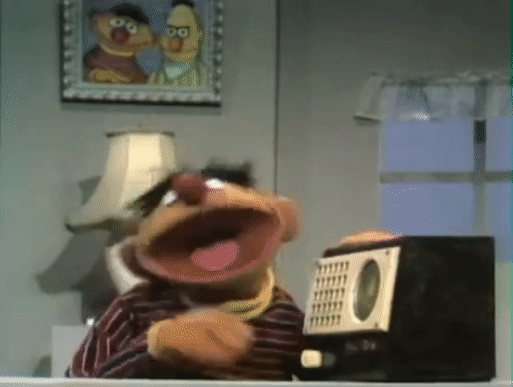
RDIDINI PROMPT ENGINEER
1 note
·
View note
Photo

Eddie's Math and Calculator Blog: HP32SII and TI-66:. Curve Fitting [email protected] #HP32SII #TI66 #statistics #curvefitting #logarithmicregression #inverseregression #logisticregression #exponentialregression #powerregression #geometricregression https://www.instagram.com/p/B2T3SFfhUih/?igshid=1xxgy1przmy2k
#hp32sii#ti66#statistics#curvefitting#logarithmicregression#inverseregression#logisticregression#exponentialregression#powerregression#geometricregression
0 notes
Photo

Preprocessing of Low Response Data for Predictive Modeling
by Farzana Naz | Imaad Shafi | Md Kamre Alam "Preprocessing of Low Response Data for Predictive Modeling"
Published in International Journal of Trend in Scientific Research and Development (ijtsrd), ISSN: 2456-6470, Volume-3 | Issue-3 , April 2019,
URL: https://www.ijtsrd.com/papers/ijtsrd21667.pdf
Paper URL: https://www.ijtsrd.com/engineering/computer-engineering/21667/preprocessing-of-low-response-data-for-predictive-modeling/farzana-naz
call for paper engineering, paper publication for engineering, engineering journal
"For training a model, the raw data have to go through various preprocessing phases like Cleaning, Missing Values Imputation, Dimension Variable reduction, and Sampling. These steps are data and problem specific and affect the accuracy of the model at a very large extent. For the current scenario, we have 2.2M records with 511 variables. This data was used in a Direct Mail Campaign of some Life Insurance Products and now we know which record had a positive response for the campaign. Rows records 2,259,747 Columns 511 Rows with positive response 2,739, i.e. Response Rate 0.1212 . The dataset is not complete, i.e. we have to take care of missing values.
0 notes
